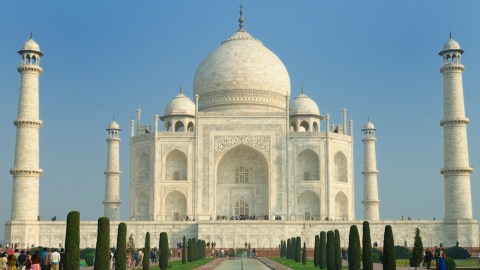How Safe is the Taj Mahal?

This post was written by Preetika Rana and originally published on the Wall Street Journal blog India Real Time.
Recent claims that the Taj Mahal is in danger of collapsing sparked panic among historians and archeologists worldwide.
Following the reports, a twin bench of Supreme Court justices D.K. Jain and A.R. Dave issued notices to the Uttar Pradesh government, the Archaeological Survey of India and the Ministry of Environment, ordering probes. The results of the probes are slated to be examined by the Supreme Court on Nov. 15.
India Real Time spoke to architect and historian Krupali Krusche about the Taj Mahal. Ms. Krusche is the Indian chairwoman of the International Network for Traditional Building, Architecture and Urbanism, as well as an assistant architecture professor at the University of Notre Dame in the U.S.
Under her leadership, the University of Notre Dame launched a Digital Historical Architectural Research and Material Analysis team in 2007, with the objective of documenting World Heritage Sites. In the summer of 2008, the team spent four weeks in India studying Mughal tombs, with a particular focus on the Taj Mahal. The team has also secured permission to 3D-scan the mausoleum in January next year.
Here are edited excerpts from Ms. Krusche’s interview with IRT:
WSJ: The first project your team undertook was to examine traditional Mughal architecture in India. What prompted you to focus on the Taj Mahal?
KK: Being of Indian origin, I have always been intrigued why the Taj Mahal has particularly mesmerized millions across the globe. As tens of thousands flock to the memorial of love each year, not many question why, how or when the mausoleum came into being. Lack of information, evidence and knowledge on the tomb’s composition, architecture and lineage is extremely disturbing. Though significant research has been conducted, Mughal architecture is still among the world’s deepest buried mysteries. The Taj Mahal is the pinnacle of Mughal renaissance, and is therefore the key to studying Mughal architecture.
WSJ: What were the tools and techniques deployed by your team to study the Taj Mahal?
KK: Modern architectural research essentially involves four techniques – photogrammetry, 3D scanning, GigaPan Systems and hand-measuring.
While the ASI [Archaeological Survey of India] initially granted permission for all of these, we were eventually allowed to practice only two techniques at the Taj Mahal – photogrammetry and hand-measuring. This was because officials at the ASI believed that 3D scans might lead to the risk of possible terror strikes. Ironically, the memorial has never been scanned, following which an accurate blueprint has never been developed.
WSJ: Brief us on major findings of your study
KK: While hand-measuring the tomb, we discovered etchings on the memorial’s pavements, which date back over 300 years. Traditionally, craftsmen engraved marks or etchings on walls and floors to proportionally align structures as per pre-conceptualized layouts. This served as an insight to techniques and tools used during Mughal reign. Another significant discovery was withering of the monument’s white marble and red sandstone structure. While air pollution and chemicals are believed to pose a major threat, our analysis determined that tourism served as the silent killer. Though a few select areas restrict entry, there are no rules or regulations that restrict hand-touching the mausoleum’s carvings, inscriptions or embellishments. Constant physical contact has darkened the white marble while the red sandstone structure is gradually decaying.
Excavations also established that the tomb had a ‘grand entrance’ for members of the royal household. Though traces of such an entrance are buried deep within the Yamuna River, evidence to its existence was substantiated by research surrounding the river and the Taj Mahal.
WSJ: Considering the memorial’s structure is decaying, are speculated claims of the collapse true?
KK: For the Taj Mahal to collapse between three to five years is near to impossible. Though research has established that the water level of the Yamuna is receding, it is baseless to conclude that the memorial might collapse altogether. My conclusion is based on two major stands. First, recent claims of the mausoleum’s minarets tilting are untrue. Architects of the Taj Mahal deliberately instituted the four minarets at an inward angle. In modern architecture, such a technique is called an optical illusion. If the minarets were to tilt slightly more than intended, mammoth cracks would immediately surface on the memorial’s base and surrounding walls.
Second, the pier-shaped foundation of the Taj Mahal is similar to that of a skyscraper. The foundations of the mausoleum are buried deep in the earth’s crust. If its base were to shift or decay, a substantial section of the tomb would sink inside the earth or bear evident signs of erosion.
WSJ: Is the ASI doing enough to protect the Taj Mahal?
KK: Though the ASI has undertaken significant measures to conserve the memorial, a major concern is their hasty approach to restoring the site. In an effort to maintain the tomb’s pristine condition, the ASI is constantly replacing worn out marble and sandstone with their immediate substitutes. During our study at the Taj Mahal, we observed local craftsmen and artisans replacing one of the memorial’s pavements. Though an architect was supervising the replacement, local workers did not appear to be adequately equipped or skilled to undertake such complex alterations.
Another startling discovery by our team was that the replaced semi-precious white marble was being dumped outside the Taj Mahal. This serves as a huge blow to the traditional lineage of the memorial and has adverse implications with regard to losing out on history.
WSJ: What are the issues that need immediate attention?
KK: Immediate stoppage to removal, replacement or dumping of stones from the memorial’s complex is of utmost importance. Further, regulations concerning physical contact with the mausoleum’s stones and carvings are a pre-requisite to conserve the tomb’s marble structure. The ASI should also recognize that immediate attention needs to be given to protect and conserve the memorial’s surrounding landscape.
Follow India Real Time on Twitter @indiarealtime.
Image provided by Shutterstock.




